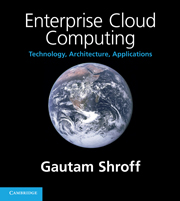Part V - Software architecture
Published online by Cambridge University Press: 06 December 2010
Summary
In this part of the book we review the fundamentals of enterprise software architecture: The information needs of many large enterprises are similar, a fact that has been exploited by packaged ERP, CRM and SCM products. Understanding how enterprise information is modeled assists in making choices regarding the applications an enterprise needs, i.e., whether to buy packaged products or build custom solutions, as well as whether to deploy systems in house or in the cloud. Software architecture principles are the key to building custom enterprise applications efficiently. Abstracting architecture patterns leads to re-use, and eventually to Dev 2.0 platforms that enable simple applications to be built without any programming. Modeling business processes and executing them using workflow engines is also a mature example of how abstraction can lead to re-use. Finally, decision support and knowledge management are becoming increasingly crucial functions of enterprise applications. Therefore, we present an overview of search and analytics techniques using a unified, and hopefully illuminating, matrix algebra formulation.
- Type
- Chapter
- Information
- Enterprise Cloud ComputingTechnology, Architecture, Applications, pp. 159 - 160Publisher: Cambridge University PressPrint publication year: 2010

